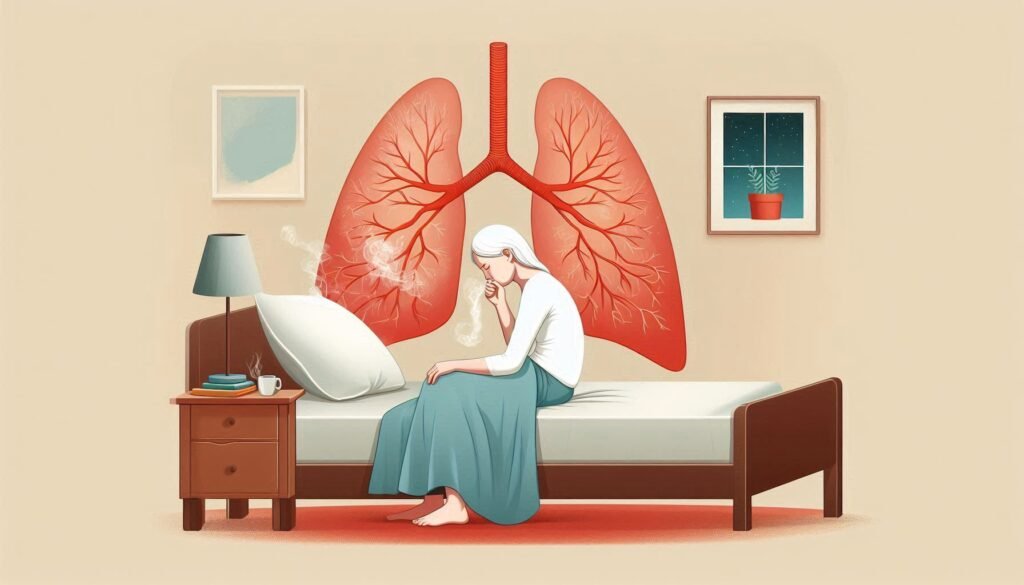Breathing is something we often take for granted—until it becomes a struggle. For those living with diffuse panbronchiolitis (DPB), the challenge of breathing can intensify, especially when lying down. This rare lung condition can lead to orthopnea, leaving patients gasping for air in the very position that should bring rest and comfort. Understanding DPB is crucial for anyone affected by this ailment or interested in its complexities.
In this article, we will explore what makes diffuse panbronchiolitis unique, how its symptoms progress from chronic cough to orthopnea, and why diagnosing it can be particularly tricky. We’ll also delve into treatment advancements that have revolutionized care and discuss practical strategies to manage sleeping difficulties associated with orthopnea due to DPB. Join us as we unpack this intricate condition and learn more about life with diffuse panbronchiolitis!

What is diffuse panbronchiolitis (DPB)? Understanding a rare lung condition
Diffuse panbronchiolitis (DPB) is a chronic inflammatory lung condition primarily affecting the small airways, known as bronchioles. It was first identified in Japan and has since been recognized worldwide, though it remains relatively rare. The inflammation characteristically leads to mucus build-up and narrowing of the air passages.
Patients with DPB often experience persistent cough, wheezing, and shortness of breath. These symptoms can significantly impact daily activities and overall quality of life. Over time, if left untreated, patients may face more severe complications related to their breathing.
The exact cause of DPB is still unclear but is believed to involve genetic predisposition combined with environmental factors like exposure to pollutants or infections. Research is ongoing into its mechanisms and effects on lung tissue.
Diagnosis typically involves imaging studies such as CT scans alongside pulmonary function tests. Early recognition is crucial for effective management; however, many individuals remain undiagnosed due to the subtlety of early symptoms.
From chronic cough to orthopnea: The progression of DPB symptoms
Diffuse panbronchiolitis (DPB) often begins with a persistent, chronic cough. This symptom can be alarming and frustrating as it may linger for months or even years. Initially, patients might dismiss this cough as a lingering cold or allergy-related issue.
As the disease progresses, individuals may start to experience increased mucus production and wheezing. These symptoms can disrupt daily life and lead to further respiratory distress. Patients frequently report feeling more fatigued due to their ongoing struggle with breathing.
Orthopnea is another significant symptom that emerges in many DPB cases. This condition refers to difficulty breathing while lying down, causing discomfort during sleep. As fluid accumulates in the lungs when horizontal, nighttime anxiety can increase dramatically.
Patients may find themselves propped up by pillows or sleeping in recliners just to catch some rest. Understanding these stages of symptom progression helps both patients and healthcare providers recognize DPB earlier on—ultimately leading to better management strategies tailored for individual needs.
Diagnosing the elusive condition: Why DPB is often misdiagnosed
Diagnosing diffuse panbronchiolitis (DPB) can be a challenging process for healthcare professionals. This rare lung condition shares symptoms with other respiratory diseases, often leading to misdiagnosis. Patients may initially present with chronic cough and shortness of breath, which are common in conditions like asthma or chronic obstructive pulmonary disease (COPD).
The unique features of DPB, such as the presence of bronchiectasis and specific radiological findings, may not be immediately recognized. Physicians might overlook these signs if they’re unfamiliar with the nuances of this disorder. As a result, many patients endure prolonged periods without appropriate treatment.
Additionally, demographic factors can complicate diagnosis. DPB is more prevalent among certain populations—especially individuals of East Asian descent—which may lead to biases in recognition based on patient ethnicity during initial assessments.
Furthermore, the rarity of DPB means that some medical practitioners simply lack experience diagnosing it. Without specialized knowledge or awareness about this elusive condition, patients risk receiving incorrect treatments that do little to address their underlying issues.
Treatment breakthroughs: How antibiotics changed the game for DPB patients
The treatment landscape for diffuse panbronchiolitis (DPB) has significantly evolved, primarily due to the introduction of antibiotics. Initially, patients faced limited options that often failed to address their severe symptoms. However, studies revealed that long-term administration of macrolide antibiotics could greatly improve lung function and reduce inflammation.
Macrolides, such as erythromycin and azithromycin, have anti-inflammatory properties in addition to their antibacterial effects. This dual action makes them particularly effective for DPB patients who struggle with chronic respiratory infections and persistent cough. Regular use can lead to significant symptom relief and improved quality of life.
Research indicates that these antibiotics can also enhance mucociliary clearance—the process by which the lungs expel mucus—and help clear blockages caused by excessive secretions. As a result, many patients report less fatigue and an increased ability to perform daily activities.
Despite these advancements in antibiotic therapy, ongoing monitoring is crucial for managing potential side effects or resistance development. As more data becomes available on long-term outcomes with this treatment approach, it continues to inspire hope among those affected by DPB.
Managing orthopnea: Strategies for comfortable sleep with DPB
Managing orthopnea can be particularly challenging for those with diffuse panbronchiolitis. Finding the right sleeping position is crucial. Many patients find relief by propping themselves up with pillows or using a wedge pillow. This elevation helps reduce pressure on the lungs, making breathing easier during sleep.
Creating a comfortable sleep environment also plays an essential role in managing symptoms. Keeping the bedroom well-ventilated and at a moderate temperature can help improve air quality and ease discomfort. Using humidifiers might further assist in maintaining moisture levels, which is beneficial for irritated airways.
Establishing a consistent bedtime routine may provide additional benefits. Engaging in relaxing activities before bed can promote better sleep quality overall. Techniques like deep breathing exercises or gentle stretching might help calm anxiety related to breathlessness.
Consulting healthcare professionals about medications that aid in relaxation or inhalation therapy may be worthwhile options to consider. Tailored solutions from medical experts often lead to improved sleep experiences for individuals grappling with orthopnea due to DPB.
Complications of untreated DPB: When breathing difficulties worsen
Untreated diffuse panbronchiolitis (DPB) can lead to serious complications that significantly impact lung function. As the condition progresses, chronic inflammation in the bronchioles can result in irreversible damage. This damage may cause a decline in respiratory health, ultimately leading to severe breathing difficulties.
Patients often experience increased mucus production and persistent cough. These symptoms may worsen over time, leading to higher susceptibility to respiratory infections like pneumonia. Such infections further complicate an already fragile situation for those with DPB.
Another significant risk is the development of pulmonary hypertension. This condition occurs when blood vessels in the lungs become narrowed or blocked, increasing pressure on the right side of the heart. Symptoms include shortness of breath and fatigue, which can severely limit daily activities.
In some cases, untreated DPB may progress to respiratory failure. Individuals could find it increasingly difficult to maintain adequate oxygen levels while resting or exerting themselves. The cycle of worsening symptoms underscores the importance of early intervention and proper management strategies for those diagnosed with this rare lung disorder.
The Asian connection: Why DPB is more common in certain populations
Diffuse panbronchiolitis (DPB) is notably more prevalent among individuals of Asian descent, particularly those from Japan and other East Asian countries. Research indicates that genetic factors play a significant role in this disparity. Certain genes associated with immune response may increase susceptibility to developing DPB.
Environmental influences also contribute to the higher incidence rates observed in specific populations. In regions where air quality is compromised or exposure to pollutants is common, individuals may be at increased risk for respiratory conditions like DPB. Lifestyle factors such as smoking are further complicating elements often found within these demographics.
Additionally, cultural practices regarding healthcare can impact diagnosis and treatment outcomes. Many patients might delay seeking medical attention due to stigma or lack of awareness about rare lung diseases like DPB until symptoms worsen significantly.
Healthcare accessibility varies by region; some communities have limited resources for proper screening and early intervention. These combined factors make understanding the Asian connection crucial for addressing DPB effectively across different populations.
Long-term outlook: Can orthopnea from DPB be fully resolved?
The long-term outlook for patients with diffuse panbronchiolitis (DPB) and its associated symptom, orthopnea, can vary significantly. While some individuals may experience substantial improvements in their breathing difficulties over time, others might face persistent challenges. This variation often depends on how early the condition is diagnosed and treated.
Effective management of DPB typically involves a combination of antibiotics and supportive therapies. For many patients, this treatment plan can lead to reduced inflammation in the lungs. As a result, symptoms like orthopnea may lessen considerably. However, achieving complete resolution is not guaranteed for everyone.
Lifestyle modifications also play a crucial role in managing DPB symptoms long term. Patients are encouraged to avoid smoking and environmental pollutants while maintaining a healthy diet and exercise routine tailored to their abilities. These changes can contribute positively to lung function.
Regular follow-ups with healthcare providers are essential for monitoring progress and adjusting treatments as necessary. With proper care, it’s possible for some individuals with orthopnea from DPB to experience notable relief over time.
Research update: New directions in understanding and treating DPB
Recent research has shed new light on diffuse panbronchiolitis (DPB), revealing potential mechanisms behind its development. Scientists are investigating the role of genetic predispositions and environmental factors that may trigger this condition in susceptible individuals. Understanding these elements can lead to more effective prevention strategies.
Innovative studies have also focused on the microbiome’s influence on lung health. Researchers are exploring how alterations in the respiratory microbiota might contribute to inflammation in DPB patients. This could pave the way for novel treatments targeting microbial imbalances, promoting better respiratory function.
Clinical trials involving targeted therapies are underway, aiming to improve treatment efficacy for DPB sufferers. These therapies include anti-inflammatory medications and biologics designed to specifically address underlying pathologies associated with DPB.
Moreover, advancements in imaging technology allow for better monitoring of disease progression. Enhanced visualization techniques help clinicians diagnose DPB earlier and tailor individualized management plans based on specific patient needs, ultimately improving outcomes for those affected by orthopnea as a symptom of diffuse panbronchiolitis.
Support for patients: Resources and tips for living with diffuse panbronchiolitis
Living with diffuse panbronchiolitis (DPB) can be challenging, but support is available. Patients should prioritize building a strong healthcare team. This includes pulmonologists who specialize in lung diseases and respiratory therapists knowledgeable about DPB management.
Educating yourself about the condition is vital. Understanding how orthopnea relates to your symptoms can empower you to take control of your health. Support groups, both online and local, offer an excellent avenue for sharing experiences and coping strategies with others facing similar challenges.
Consider incorporating lifestyle changes that promote better lung function. Quitting smoking, if applicable, remains crucial as it can exacerbate symptoms like orthopnea. Regular gentle exercise may also improve overall respiratory health while ensuring safety through guidance from healthcare professionals.
Diet plays an essential role too; maintaining a balanced diet helps strengthen the immune system and manage chronic inflammation associated with DPB. Staying hydrated supports mucus clearance in the lungs.
Don’t hesitate to reach out when feelings of isolation or anxiety arise due to this rare condition. Mental wellness matters just as much as physical well-being—look for counselors or psychologists familiar with chronic illness impacts on mental health.
Resources are abundant—from educational materials provided by hospitals to community programs focused on lung disease awareness—and they all play a part in navigating life with diffuse panbronchiolitis more smoothly.


